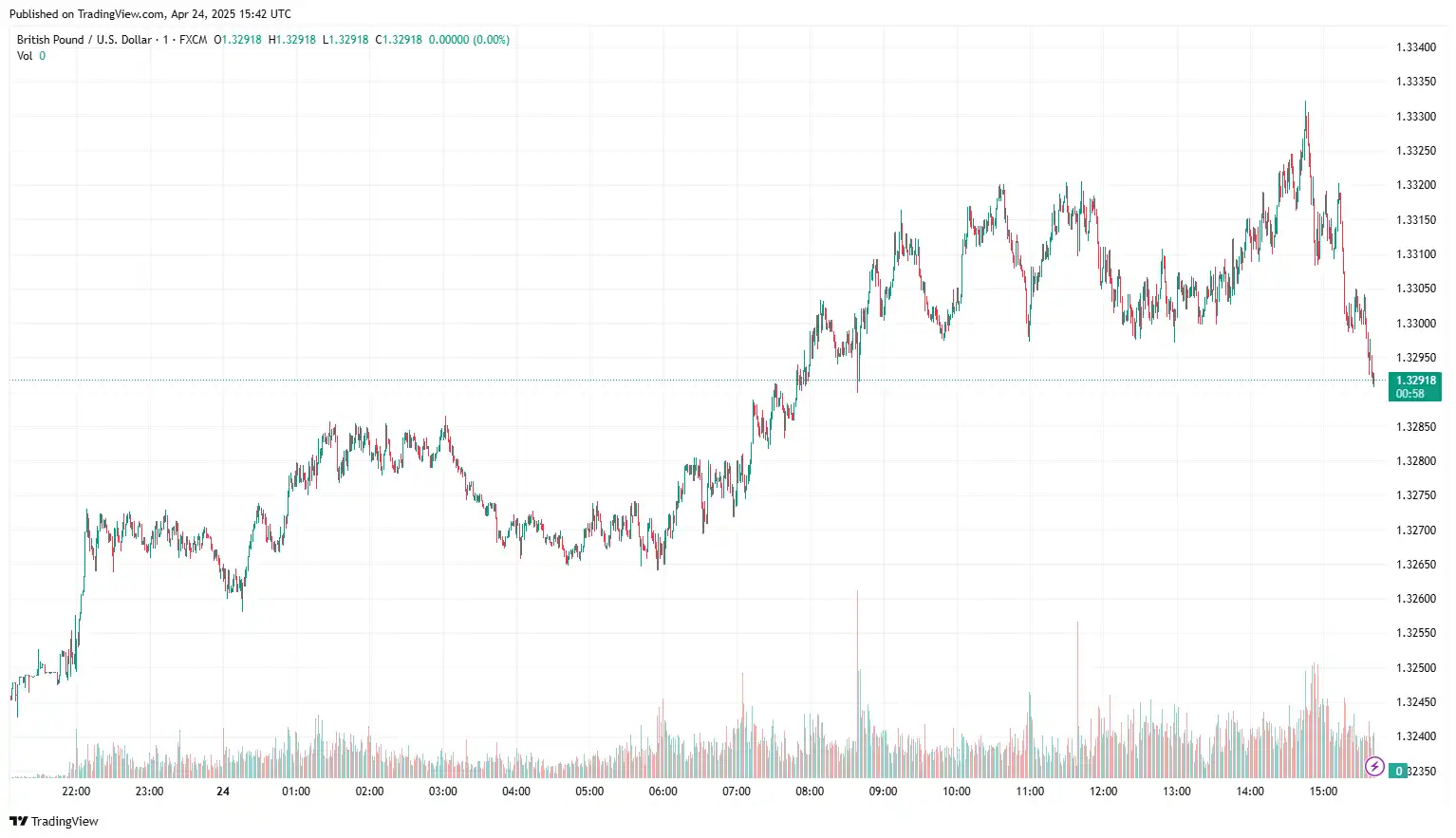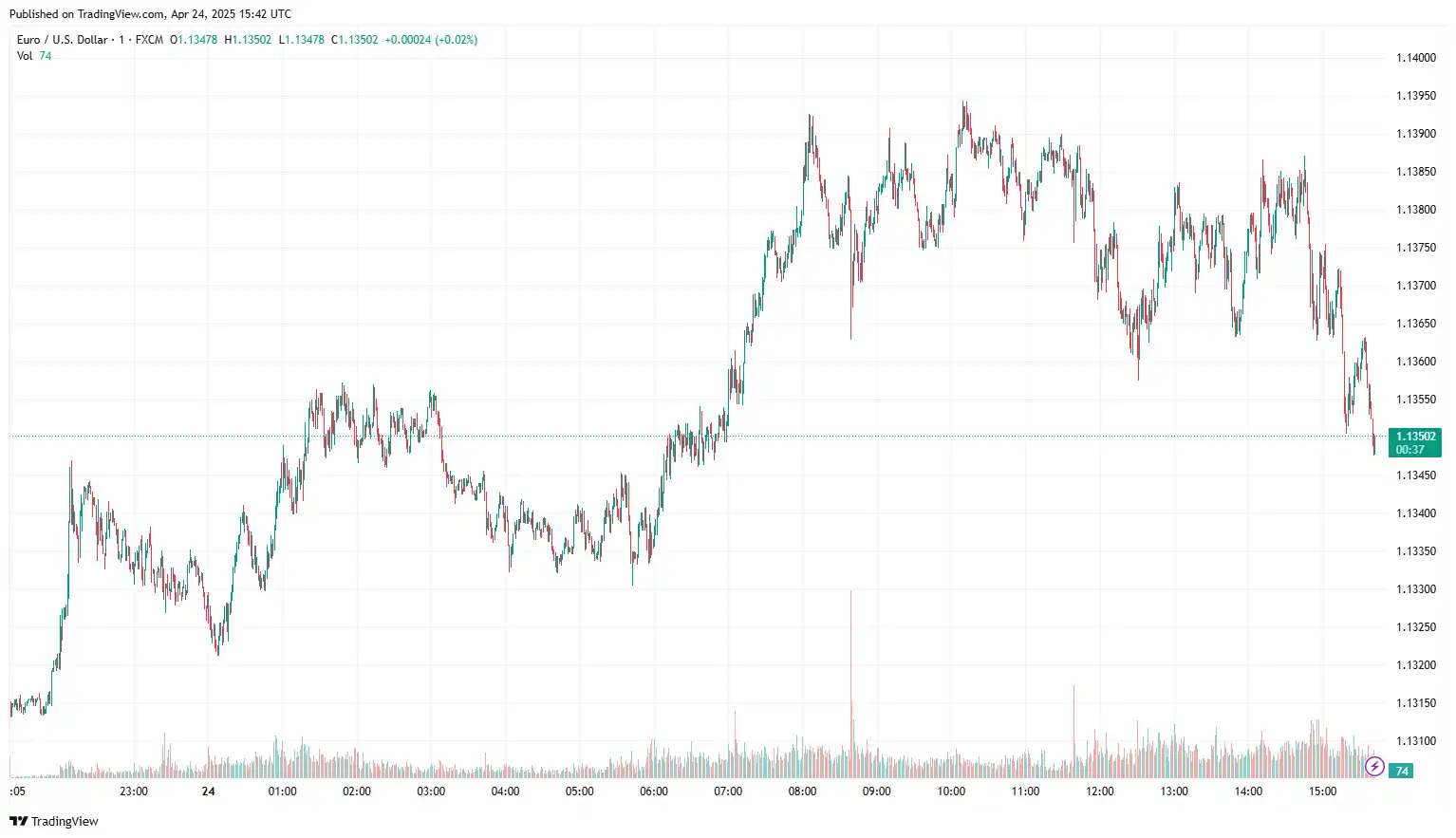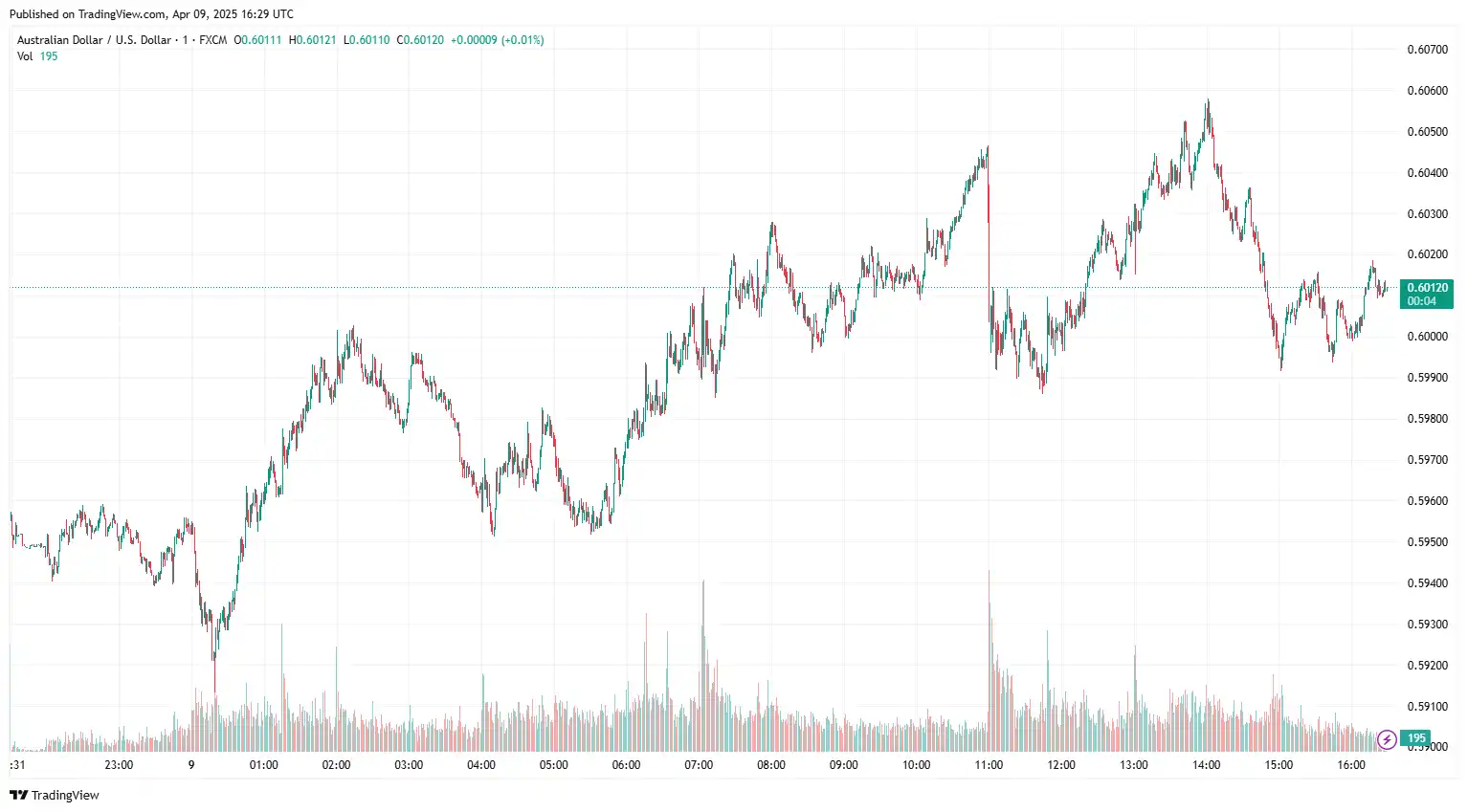GBP/USD Rebounds on Fresh Trade Uncertainty
GBP/USD recovered near 1.3286 amid renewed concerns over potential tariff threats and mixed S&P Global Purchasing Managers' Index (PMI) data. S&P Global's Flash US Composite PMI Output Index, which tracks the manufacturing and services sectors, eased to 51.2 in April, down from 53.3 previously. This figure marks the lowest level since December 2023. Meanwhile, the Manufacturing PMI rose to 50.7 in April, up from the prior reading of 50.2 and surpassing the estimated 49.4. The Services PMI declined to 51.4 in April from 54.4 in March, falling short of the market consensus of 52.8. S&P Global's Chris Williamson emphasised slowing growth momentum, highlighting that persistent inflationary pressures will influence the Federal Reserve's monetary policy stance. On Tuesday, US Treasury Secretary Scott Bessent commented that the ongoing tariff dispute is "unsustainable," implying potential de-escalation. On Tuesday, the White House announced advancements in trade talks aimed at reducing the broad tariffs imposed earlier this month. Press Secretary Karoline Leavitt noted that 18 countries have already presented trade proposals. This week, President Trump's team is scheduled to meet with representatives from 34 nations to discuss potential agreements. Additionally, US President Trump declared that he had no intention of firing Federal Reserve Chair Jerome Powell, despite his frustration with the central bank's hesitation to lower interest rates more quickly, highlighting shifts in the economic outlook, which adds volatility to the greenback. Wednesday's Federal Reserve (Fed) Beige Book report cited that businesses were having trouble with the early stages of Trump's tariffs and managing the rising costs. Moreover, a murky US economic outlook triggered by Trump's tariff threats could undermine the USD in the upcoming sessions.
On the other hand, weaker-than-expected S&P Global/CIPS PMI data for April pressured the sterling. The seasonally adjusted S&P Global/CIPS UK Manufacturing Purchasing Managers' Index (PMI) eased to 44 in April, down from 44.9 in March, showing an unexpected contraction in the overall business activity. The data aligned with the market consensus of 44 for the reported period. Meanwhile, the Preliminary UK Services Business Activity Index contracted to 48.9 in April, compared to 52.5 in March, indicating that rising global economic uncertainty and subdued domestic demand conditions, falling short of the expected figure of 51.3. A market expectation that the Bank of England (BoE) will choose to ease monetary policy at May's meeting due to slower-than-expected growth in the Consumer Price Index (CPI) for March and uncertainty regarding the global economic outlook adds pressure on the pound.
In the upcoming session, US weekly Initial Jobless Claims, Chicago Fed National Activity Index, Durable Goods Orders, and Existing Home Sales, along with UK Retail Sales data for March, will shape the market sentiment around the GBP/USD exchange rate.

EUR/USD Struggled on Gloomy Fed's Beige Book
EUR/USD hovered near 1.1378, as market speculation that the European Central Bank (ECB) will reduce interest rates again at the June policy meeting, coupled with recent HCOB's latest Purchasing Managers' Index (PMI) data, weighs on the shared currency. The Eurozone's Manufacturing Purchasing Managers' Index (PMI) rose to 48.7 in April, up from 48.6 in March, exceeding market expectations of 47.5. Conversely, the bloc's Services PMI decreased to 49.7 in April from 51 in March, falling short of the forecasted 50.5, marking the lowest level in five months. The HCOB Eurozone PMI Composite recorded 50.1 in April, down from March's 50.9, compared to a market consensus of 50.3. Additionally, the HCOB Manufacturing PMI for the largest economy in the Eurozone fell to 48 this month, down from 48.3 in March and above the prediction of 47.6, indicating a two-month low. At the same time, the Services PMI fell to 48.8 in April from 50.9 in March, with the market expecting a print of 50.2 for the period, marking a 14-month low. The HCOB Preliminary German Composite Output Index was at 49.7 in April, down from 51.3 in March and lower than the expected 50.4, hitting its lowest point in four months. Business sentiment in Germany showed a slight improvement in April, with the IFO Business Climate Index increasing to 86.9 from 86.7 in March, surpassing market expectations of 85.2. Furthermore, the report revealed that the IFO Current Assessment Index rose to 86.4 from 85.7, while the Expectations Index slightly decreased to 87.4 from 87.7.
On Wednesday, ECB policymaker and Bundesbank President Joachim Nagel reiterated that he expects "Eurozone inflation to return to 2% over this year," even when the "level of uncertainty is extraordinarily high." Nagel cautioned that the German economy could experience a mild recession for the third consecutive year in light of the tariffs announced by US President Trump. German Finance Minister (FM) Joerg Kukies' comments, "The position is very simple: Plan A is that we want an agreement and the tariffs should go down instead of going up, and Plan B is if this doesn't work, we will use countermeasures," reignited optimism around the Eurozone-US trade talks.
Conversely, the US Dollar Index (DXY), which tracks the greenback’s value against six major currencies, struggled due to weaker economic activity, hampered by the fears of a potential economic slowdown. Chris Williamson, Chief Business Economist at S&P Global Market Intelligence, commented, "The early flash PMI data for April point to a marked slowing of business activity growth at the start of the second quarter, accompanied by a slump in optimism about the outlook. At the same time, price pressures intensified, creating a headache for a central bank which is coming under increasing pressure to shore up a weakening economy just as inflation looks set to rise." Moreover, President Trump alleviated concerns about removing Jerome Powell despite criticising him for not supporting the expansion of monetary policy, stating, "The press runs away with things. No, I have no intention of firing him. I would like to see him be a little more active in terms of his idea to lower interest rates."
In today's session, US labour market data and Germany's business climate indicator will be key drivers for the EUR/USD's movements.

AUD/JPY Tumbled as Safe-Haven Demand Lifts Yen Amid Trade Uncertainty
AUD/JPY traded near 90.96 amid market anticipation that Japan would strike a trade deal with the US and the Bank of Japan (BoJ) would increase interest rates in upcoming meetings, rejuvenating demand for the safe-haven JPY. Japan's National Consumer Price Index (CPI) rose by 3.6% year-on-year (YoY) in March, compared to the previous reading of 3.7%, according to the latest data released by the Japan Statistics Bureau on Friday. Further details reveal that the National CPI excluding fresh food stood at 3.2% YoY in March, up from 3.0% prior. This figure aligned with the market consensus of 3.2%. CPI excluding fresh food and energy increased by 2.9% YoY in March, compared to the previous reading of 2.6%. Meanwhile, the preliminary Purchasing Managers' Index (PMI) released on Wednesday indicated that Japanese manufacturing activity declined for the tenth consecutive month in April. The au Jibun Bank manufacturing PMI registered at 48.5 in April, slightly higher than 48.4 in the previous month. In contrast, Japanese services activity rebounded, and the au Jibun Bank Services PMI increased to 52.2 during the reported month compared to a neutral reading of 50.0 in March. On Thursday, Japan's Finance Minister Katsunobu Kato expressed disappointment about US tariffs during a meeting with G7 nations, noting the uncertainty they create for financial markets. In addition, Japan's Economic Revitalisation Minister Ryosei Akazawa is scheduled to visit the US for discussions on tariffs starting April 30. Last week, Bank of Japan Governor Kazuo Ueda indicated that the central bank might have to implement policy changes if US tariffs negatively impact the Japanese economy. Furthermore, reports suggest that the BoJ may revise its economic growth forecasts downward and highlight increasing risks due to Trump's extensive trade tariffs.
On the other hand, the Australian Dollar (AUD) remains steady despite the dented market mood after Treasury Secretary Scott Bessent stated that the existing tariffs on China are unsustainable and might decrease "in a mutual way." The Judo Bank Manufacturing PMI decreased to a two-month low of 51.7 in April, down from 52.1 in March. While manufacturing output continued to show expansion, the rise in new orders was modest. Meanwhile, the Services PMI slightly declined to 51.4 from 51.6 in the previous month, and the Composite PMI also fell to 51.4 from 51.6. Recent Reserve Bank of Australia (RBA) meeting minutes highlighted the uncertainty around the timing of the next interest rate adjustment, primarily due to persistent uncertainty in global trade and geopolitics. While the Board deemed the May meeting suitable for evaluating monetary policy, it emphasised that no prior decisions had been established. Additionally, the Board highlighted risks, both positive and negative, confronting Australia's economy and inflation path. Moreover, cautious market sentiment regarding the persistent US-China trade dispute continues to undermine the risk-sensitive Aussie despite robust economic growth, industrial production, and retail sales.
Amid a lack of Australian data, broader market sentiment around the US trade deals and Donald Trump's comments on US tariffs on China will drive the AUD/JPY exchange rate.

EUR/GBP Fluctuates Amid Optimism Over Potential US-China Trade Negotiations
EUR/GBP struggled near 0.8555 as the euro gained ground over the renewed optimism over potential US-China trade negotiations. Recent remarks from Trump expressed optimism regarding the ongoing trade negotiations with China, indicating positive signs and adding that tariffs on Chinese goods wouldn't be as high as 145%; however, he clearly stated that tariffs wouldn't be exempted entirely. In April, the Eurozone's Manufacturing Purchasing Managers' Index (PMI) increased to 48.7, a rise from March's 48.6 and surpassing market forecasts of 47.5. However, the bloc's Services PMI dropped to 49.7 in April from 51 in March, falling short of the anticipated 50.5 and reaching its lowest level in five months. The HCOB Eurozone PMI Composite came in at 50.1 in April, down from 50.9 in March, below the consensus of 50.3. Additionally, the HCOB Manufacturing PMI for the Eurozone's largest economy decreased to 48 this month from 48.3 in March, which was above the prediction of 47.6, indicating a two-month low. Meanwhile, the Services PMI decreased to 48.8 in April from 50.9 in March, against an expected 50.2, marking a 14-month low. The HCOB Preliminary German Composite Output Index registered at 49.7 in April, down from March's 51.3 and lower than the expected 50.4, marking its lowest point in four months. Business sentiment in Germany showed modest improvement in April, with the IFO Business Climate Index rising to 86.9 from 86.7 in March, surpassing market expectations of 85.2. Furthermore, the report indicated that the IFO Current Assessment Index increased to 86.4 from 85.7, while the Expectations Index slightly fell to 87.4 from 87.7.
Conversely, weaker-than-anticipated S&P Global/CIPS PMI data for April weighed on the sterling. The seasonally adjusted S&P Global/CIPS UK Manufacturing Purchasing Managers' Index (PMI) declined to 44 in April from March's 44.9, indicating an unexpected contraction in overall business activity. This figure matched the market consensus of 44 for the period. Additionally, the Preliminary UK Services Business Activity Index fell to 48.9 in April, down from 52.5 in March, reflecting rising global economic uncertainty and weaker domestic demand, which was below the expected 51.3. Expectations that the Bank of England (BoE) may opt to ease monetary policy during May's meeting due to disappointing growth in the Consumer Price Index (CPI) for March and global economic uncertainty further pressure the pound. At an International Monetary Fund (IMF) event, Bank of England (BoE) Governor Andrew Bailey emphasised that the central bank must take the risk to economic growth from global trade disruptions very seriously, adding, 'Fragmenting the world economy will negatively impact growth. The UK operates as an open economy, so the US's relationship with the rest of the world is significant. We must seriously consider the risk to growth. China has experienced a prolonged period of weak household domestic demand, which is not sustainable indefinitely. The Bretton Woods system is the best one we have, but it faces challenges.'
In today's session, the Confederation of British Industry's (CBI) latest surveys and key economic data from Germany will influence the EUR/GBP exchange rate.

Stay Ahead in the Currency Game
Whether you're a daily FX trader or handle international transactions regularly, our 'Currency Pulse' newsletter delivers the news you need to make more informed decisions. Receive concise updates and in-depth insights directly in your LinkedIn feed.
Subscribe to 'Currency Pulse' now and never miss a beat in the currency markets!
Ready to act on today’s insights? Get a free quote or give us a call on: +44 (0)20 7740 0000 to connect with a dedicated portfolio manager for tailored support.
Important: This blog is for informational purposes only and should not be considered financial advice. Currency Solutions does not consider individual investment goals, financial circumstances, or specific requirements of readers. We do not endorse or recommend any particular financial strategies or products discussed. Currency Solutions provides this content as is, without any guarantees of completeness, accuracy, or timeliness.




